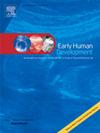波兰不同类型军种的数字比率(2D:4D)的变化
IF 2
3区 医学
Q2 OBSTETRICS & GYNECOLOGY
引用次数: 0
摘要
研究背景手部第二指(2D)和第四指(4D) (2D:4D)之间的关系被认为是妊娠前三个月产前睾酮(PT)和雌激素(PE)暴露的代理指标。2D:4D较低表明PT暴露相对较高,反之亦然。女性的2D:4D通常高于男性。较低的2D:4D与更强的身体能力、力量、更好的运动表现以及更倾向于需要更多身体健康和更危险的工作有关。本研究的目的是检查波兰三组男性之间2D:4D的差异,如果有的话:军事学生(N = 250),陆军士兵(N = 106)和国土防卫部队志愿者(N = 202)。方法在波兰弗罗茨瓦夫陆军军事大学(MULF)进行横断面研究。测量结果包括身高、体重、双手食指和无名指的长度。结果陆军士兵和军校学生的2D:4D明显低于国防军学生。结论胎儿雄激素可能影响人的特定能力以及对挑战性职业的选择。本文章由计算机程序翻译,如有差异,请以英文原文为准。
Variation in digit ratio (2D:4D) across different types of military services in Poland
Background
The relationship between the second (2D) and fourth finger (4D) of the hand (2D:4D) is considered to be a proxy indicator of prenatal- testosterone (PT) and estrogen (PE) exposure in the first trimester of pregnancy. A lower 2D:4D indicates relatively higher PT exposure and vice versa. The 2D:4D is generally higher in women than in men. Lower 2D:4D is associated with greater physical ability, strength, better athletic performance, and a propensity for jobs that require more physical fitness and are more risky.
Aim
The aim of the present study was to examine the differences in 2D:4D, if any, between three groups of men in Poland: military students (N = 250), soldiers of the Land Forces (N = 106) and volunteers of the Territorial Defense Force (N = 202).
Method
This cross-sectional study was carried out in Military University of Land Forces (MULF) in Wroclaw, Poland. The measurements included body height, body weight and the lengths of the second and fourth fingers in both hand of each participant.
Results
The results showed significantly lower 2D:4D in land forces soldiers and military students than those belonged to the Territorial Defense Force.
Conclusion
The results indicated the possible impact of fetal androgens on specific human abilities as well as choices for challenging occupations.
求助全文
通过发布文献求助,成功后即可免费获取论文全文。
去求助
来源期刊

Early human development
医学-妇产科学
CiteScore
4.40
自引率
4.00%
发文量
100
审稿时长
46 days
期刊介绍:
Established as an authoritative, highly cited voice on early human development, Early Human Development provides a unique opportunity for researchers and clinicians to bridge the communication gap between disciplines. Creating a forum for the productive exchange of ideas concerning early human growth and development, the journal publishes original research and clinical papers with particular emphasis on the continuum between fetal life and the perinatal period; aspects of postnatal growth influenced by early events; and the safeguarding of the quality of human survival.
The first comprehensive and interdisciplinary journal in this area of growing importance, Early Human Development offers pertinent contributions to the following subject areas:
Fetology; perinatology; pediatrics; growth and development; obstetrics; reproduction and fertility; epidemiology; behavioural sciences; nutrition and metabolism; teratology; neurology; brain biology; developmental psychology and screening.
 求助内容:
求助内容: 应助结果提醒方式:
应助结果提醒方式:


